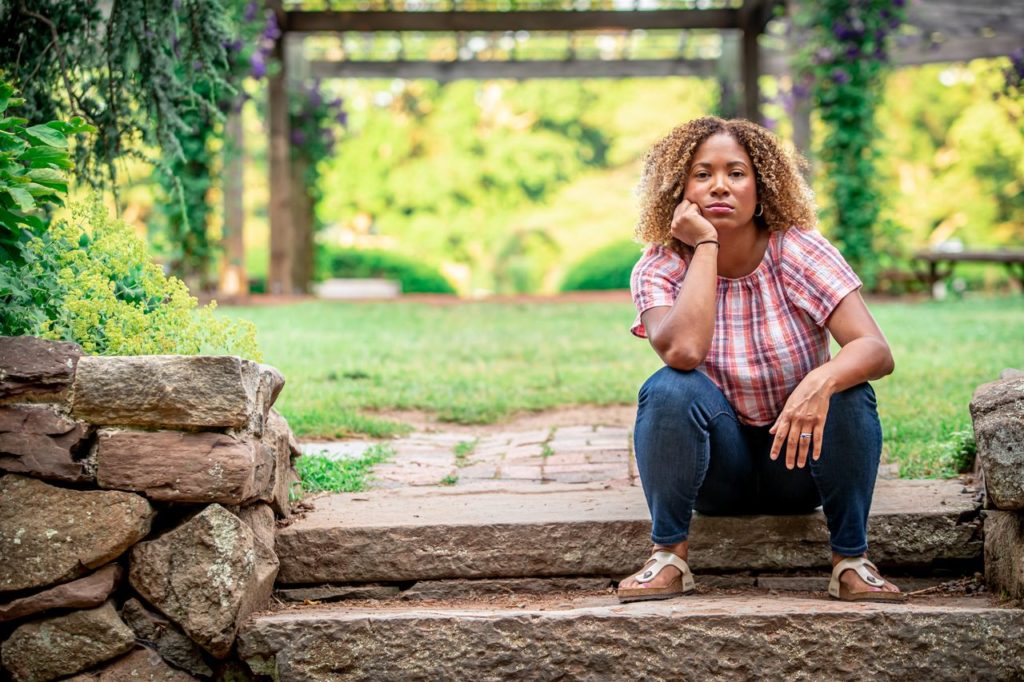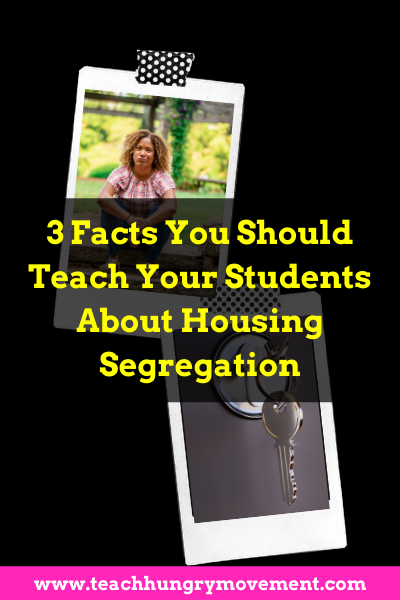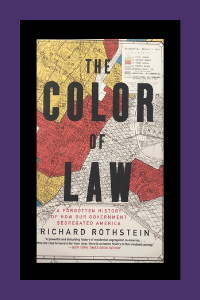Imagine this. You’re standing in front of your class. You’re about to teach start your lesson about segregation by law. You know, de jure segregation.
You’re looking out at your students. Ok, let’s be real. You’re most likely sitting in front of your computer looking at your students on Zoom. Or in my case, Google Meet. Maybe you see some brown faces. Perhaps you see kids of all races who are from lower socioeconomic backgrounds.

Regardless, you’re thinking about President Trump’s recent warnings to “suburban housewives.”
Trump stated that a Biden Presidency will “totally destroy the beautiful suburbs. Suburbia will no longer be as we know it. So they wanted to defund and abolish your police and law enforcement while at the same time destroying our great suburbs.”
The undertones are clear. We must protect the suburbs from black and brown people. (Oh, and poor people too).
As a mixed-race woman, this is a big f-u to me. Image how many of your students feel.
The implication is clear.
People of color are so criminal, they have so little value that housing values will go down. And they don’t deserve to live where they want.
Not everyone wants to live in the suburbs. Let’s face it, they can be pretty boring. But many people do. And everyone should have that opportunity.
It also supports the tired trope that safe = white and wealthy.
Now, you may be thinking, “here she goes again, bashing Trump.” That’s not the intent of this post. I’m callin’ it like I see it. The president is using dog-whistles and clichés to scare suburban white folks to the polls.
Don’t fall for it.
So why am I telling you this?
If you want to be a social justice educator, you have to have hard conversations. Talking about race is hard. Talking about socio-economics is hard.
Yes, you will get pushback. That’s ok.
Many U.S. History teachers teach about the creation of the suburbs when they get to the 1950s. Unfortunately, we leave out a huge story. I know I’m guilty of it, and I vow to change how I teach this topic the next time I teach U.S. History.
So, what do we leave out? – Segregation in housing
The federal government was at the forefront of segregation by law. They made it virtually impossible for black people to buy homes. Trapping them in overcrowded urban spaces.
This meant they couldn’t create wealth, attend good schools, or maintain property. This created the slum conditions we associate with people of color. Especially Black people.
Since we don’t teach this history, people don’t know why we have ghettos and suburbs. They don’t understand why poor brown people can’t just work hard and move out of the ghetto.
They blame them for their situation, even though it’s been 100 years in the making. We often think that de jure segregation was a system created by local and state governments. But, the federal government had its hand in de jure segregation too.
If we’re going to change things, we need to teach our students why things are the way they are. One of you might be teaching a future policymaker. They need to know the accurate, non-whitewashed history.
The Color of Law
Over the summer, I read a book called The Color of Law by Richard Rothstein. It’s about the federal government’s role in housing segregation.

It rocked my world.
I obviously can’t teach you everything in this one post. You’ll have to read the book for that.
Seriously.
Read the book.
I’ll give you the information that smacked me in the face real hard. The information that changed my viewpoint of the federal government.
My education on the Civil Rights Movement, taught me that the federal government did a good job. And they did. If we left civil rights up to the states, well, I’d probably be a slave today.
And no, that’s not extreme.
But the federal government did a lot of shady sh*t throughout the 20th century. Sh*t that impacts Black folks to this day.
After reading this book, I was shocked by how f-ed up the federal government has been. And how active it’s been in discriminating against black people. Especially in housing.
I guess I’m naive.
After reading the book, I’ve listed 12 things you need to know about creating the suburbs in America. And ideas for teaching them.
Try not to be as sassy as I’m being in this post. Or be as sassy as you want. Do you, boo .
Since this is a meaty topic and would be the longest blog post I’ve ever written, I’ve broken it up into several posts. Here my first three takeaways about housing segregation from the book (along with my janky citations):
1. Segregation caused Black people to have limited housing options
When you think of public housing or the projects, what do you think of?
Come on. Do it.
I know it’s hard to admit, but you most likely thought of poor black and brown people.
I mean, I did too. My dad grew up in the projects. My former students in NYC lived in the projects (for the most part), the media (especially tv and movies) tell us this.
But did you know that the projects were actually built for white people? At least nice public housing.
The influx of war workers during WWII was so rapid that housing couldn’t keep up. So the federal government had to step in. The federal government created most public housing for these war workers. This housing was segregated. Black housing was poorly constructed and designed to be temporary (Rothstein, 5).
The impact of this planned segregation is still felt today.
Housing projects are still segregated by race. And suburbs are still predominantly white.
Get this sh*t. Federal officials only approved bank loans for suburban housing for whites.
I had to put the book down.
I knew about redlining and I’ve taught about it. But I didn’t know this.
So, construction companies couldn’t get bank loans to build homes for Black people. AND no houses could be sold to black people.
Got it.
The federal government also refused to insure blank loans for Black housing. Making construction unaffordable.
Additionally, most post-WWII public housing was for working and middle-class white people. In 1940, the Lanham Act was passed to finance housing for workers in defense industries.
In some cities, war housing was for whites only. This left blacks in slums and restricted access to jobs because they lived too far away to commute (25).
Get this. You know how we always talk about how history repeats itself?
Well, here’s a prime example from Detroit Mayor Edward Jeffries:
In his 1945 re-election campaign, he had a warning for white suburbanites. Projects for Black people would be put in their neighborhoods if his opponent won (27).
Sound familiar?
By the 1940s, whites could buy houses in the private market while Blacks were stuck in public housing.
Landlords discriminated against Blacks creating a bigger housing shortage than whites. There were even vacant units in white projects. But of course, Black folks couldn’t fill them (27).
After WWII, there was another housing crisis. This time a civilian housing crisis. Since so many people were coming back from the war and needed a roof over their heads.
President Truman initiated a new public housing effort. But, conservative Republicans said that the Lanham Act was only a war effort. They pushed to end the program.
To make sure that happened, they got real manipulative and shady.
Conservative Republicans included an amendment prohibiting segregation and racial discrimination in public housing. Knowing full well that the Southern Democrats would kill the bill.
It worked.
The 1949 Housing Act allowed local authorities to continue to segregate housing (31).
2. Impacts of segregation on Black Americans
Lack of housing and segregation made Black folks more removed from mainstream society. They often had to drive hours to and from work. Leaving little time for leisure and little leftover money for home improvement projects.
Black people were often forced to live in temporary housing or high-rise ghettos. These conditions perpetuated the cycle of poverty and slum conditions (32).
To add insult to injury as middle-class whites left urban areas for the suburbs, so did the tax base.
The money needed to support thriving communities left with them. So did access to jobs and social services. Community policing became impractical (37).
Often we hear people say, “why don’t they just leave?”
Well, don’t you think people have that??
When Trump says stuff like:
“I am happy to inform all of the people living their Suburban Lifestyle Dream that you will no longer be bothered or financially hurt by having low income housing built in your neighborhood…”
it harkens back to the bans on apartment complexes in the suburbs of the past.
Often these complexes were low-income or less expensive to rent compared to owning a home.
If that ain’t a real kick in the head, there has historically been a move to clear the slums.
It’s like people can’t win.
Black and brown people aren’t wanted in the suburbs, and they aren’t wanted in the cities either.
Slum Clearance
Slum clearance happened when public officials moved Blacks from downtown business areas (127).
So white commuters, shoppers, and business elites could avoid Black people.
Wow.
When this change happened, there was no relocation effort. It forced people to move in with friends or relatives or leave the area entirely. This made overcrowding and slum conditions worse.
When they did leave, they weren’t welcome in white middle-class communities. Because they were poor—one of the fears that Trump is trying to stoke with white middle-class voters.
Another tool for slum clearance was the federal highway system (127). Building the federal highway system was a great thing for the country as a whole. But it destroyed urban communities. Not to say that non-urban places weren’t affected.
But there was a disproportionate impact on poor urban communities of color.
The final slap in the face was that there was no help for lodging (129). So people were kicked out of their neighborhoods and given no money to find a temporary place to stay.
3. Housing Conditions for White people vs. Black people
If all that wasn’t enough, there were differences in conditions for Blacks and whites. As with all segregation, the concept of “separate but equal” is horse sh*t.
White projects had better facilities, amenities, services, and maintenance.
Other disparities were common. In Miami, Black people who qualified for public housing were assigned to projects. While white folks were given vouchers to rent private apartments where they wanted (36).
It wasn’t just the federal government who was this sh*tty.
The real estate lobby had their hand in discriminating against Black people, too.
Once the WWII housing shortage ended, the real estate lobby pounced. They restricted public housing to the most impoverished families. This forced middle-class families out of the projects in the 1950s (36).
While white middle-class families had the freedom to move to the suburbs, Blacks families didn’t.
Since building maintenance workers were middle class, they were also forced out. This led to building deterioration. The loss of middle-class residents led to inadequate maintenance budgets. Again, leading to the decline of the buildings (37).
Lastly, it removed people with political strength. Leaving fewer people to fight for money for upkeep & amenities (37).
If all this wasn’t enough, many local governments taxed Blacks more than Whites.
How did they do this, you ask?
Assessors overassessed Black properties and under-assessed White properties. Again, leading to the deterioration of neighborhoods. People had less money in their pockets for maintenance (170).
The effects of overtaxing compounded overtime. And segregation imposed a higher expense on blacks than whites. Even if their tax rates and wages were identical (170).
But yes, let’s keep blaming poor people for their living conditions.
Ok, so how do you teach this to students?
I would add this topic to any activities you do about World War II on the Homefront. (You could even go as far back as WWI).
I do a stations activity about the Homefront. If you do something similar, you could add a station dealing with housing. We always talk about creating jobs and how WWII got the U.S. out of the Great Depression. But we rarely discuss housing (besides the G.I. Bill). Yet those new workers needed a place to live. So, the conversation about housing is relevant and vital to understanding racial dynamics.
More Ideas:
- Make connections between urbanization, suburbanization, and gentrification.
- Have students create a timeline of urban issues throughout the 20th century.
- Have the students look at local issues.
- They can conduct research about segregtation laws in their hometown.
- You could use these issues as a segue into your discussion of the growth of the suburbs in the 1950s.
So, there you have it.
Some of the things you need to know about de jure segregation and the suburbs. This will help you teach an accurate, inclusive version of this history.
Oh, and it will help you when your bone-head cousin says something dumb about brown people ruining the suburbs.
Be sure to check out The Color of Law by Richard Rothstein.

AND
Stay tuned for my next installment of facts about the suburbs that will piss you off.
Here are some of the articles I read that sparked the fire the helped me write this post:
- Trump tries to win over ‘Suburban Housewives’ with repeal of anti-segregation housing rule
- Trump appeals to ‘Suburban Housewives of America’
- Down In The Polls, Trump Pitches Fear: ‘They Want To Destroy Our Suburbs’
Like what you read? Check out more on the blog.
Or check out a couple of my faves:
+ show Comments
- Hide Comments
add a comment